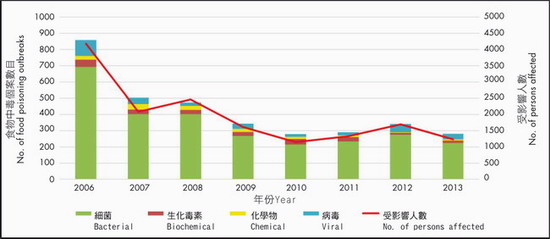
Food Safety Focus (93rd Issue, April 2014) – Incident in Focus
Review of Food Poisoning Outbreaks Related to Food Premises and Food Business in 2013
Reported by Dr. Karen CHEUNG, Medical & Health Officer,
Food Incidents Response & Management Unit,
Centre for Food Safety
This article reviews the food poisoning outbreaks related to local food premises and food business reported to the Centre for Food Safety (CFS) in 2013.
Food Poisoning Outbreaks Related to Local Food Premises and Food Business
The CFS, in collaboration with the Department of Health (DH), is responsible for the investigation and control of foodborne disease outbreaks related to local food premises and food business. In 2013, the CFS received 285 referrals from the DH on food poisoning outbreaks affecting 991 persons. The annual number of referrals decreased generally from 2006 to 2010 and had since remained more or less stable over the past three years, between 280 to 350 cases per year (see Figure).

Number of food poisoning outbreaks related to food premises and food business by causative agent and the corresponding number of persons affected from 2006 to 2013
Causative Agents and Contributing Factors
Bacterial foodborne agents remained the leading cause (80%) of all food poisoning outbreaks in 2013, with Vibrio parahaemolyticus, Salmonella and Clostridium perfringens being the top three bacterial pathogens. For the viral causes, norovirus, associated with the consumption of raw/undercooked bivalves, was found to be the exclusive viral agent causing 12% of all the outbreak referrals. For the remaining 8%, ciguatoxin, calcium oxalate and tetrodotoxin were the incriminated chemical/biotoxin causing the food poisoning cases.
Of the 285 cases investigated last year, inadequate cooking, improper holding temperature and contaminated raw food were the most frequently identified contributing factors.
Cooking Adequately -- Is it Enough?
Below is a cluster of food poisoning outbreaks illustrating the importance of food safety practices concerning the areas of thorough cooking and choosing safe raw ingredient, followed by a brief discussion on pufferfish poisoning.
A Cluster of Food Poisoning Outbreaks related to Inadequate Cooking
In October 2013, three food poisoning outbreaks affecting a total of six persons were reported to the CFS. Epidemiological investigation of these cases suggested Salmonella food poisoning related to the consumption of "Banana Soufflé in Red Bean Paste". A food sample collected at the restaurant was tested positive for Group D Salmonella and a stool sample of one of the victims was also tested positive for Salmonella. Further testing of the type and pattern of the two bacteria samples revealed that they were likely to be from the same origin. The bacteria could have contaminated the raw ingredients or being introduced following lapse of hygienic practice by the food handlers, but the stool samples of all related food handlers were tested negative for Salmonella, contamination of the raw ingredient followed by inadequate cooking was the most likely contributing factor to this cluster of outbreaks. Specific health advice was therefore conveyed to the food handlers and restaurant management. Sale of the food item was suspended pending the review of the procedural guide on its preparation to ensure food safety before reinstatement. Prosecution against the licensee for selling food unfit for human consumption is in progress.
Local Situation of Tetrodotoxin or Pufferfish Poisoning
Tetrodotoxin is a potent marine neurotoxin. It is mainly distributed in the ovaries, livers and skins of various marine species such as some pufferfish, porcupine fish, starfish, etc. The toxin is both heat- and acid-stable and thus cannot be destroyed by cooking, drying or freezing.
Since 2003, a total of ten outbreaks of pufferfish poisoning involving 20 victims had been reported. Four of the cases were reported in 2013. Numbness, peripheral weakness and dizziness were the commonly reported symptoms with a latency period ranged between two minutes to 24 hours. All victims had sought medical care and 15 of them were admitted to hospital with one requiring intensive care. All had since recovered with no known complication.
The fish in six out of these ten outbreaks were acquired locally, either through local fishmongers or patronising local food premises. It is therefore important to heighten the awareness of the general public and fishmongers on the risk of tetrodotoxin poisoning, which may result in fatal consequence.
Conclusion
It is observed that the number of food poisoning outbreaks has remained at a relatively low level over the past few years. While the government will continue to be vigilant in safeguarding food safety, the trade and the public are advised to adopt and adhere to the "Five Keys to Food Safety" to address the common contributing factors of food poisoning in order to prevent the occurrence of future outbreaks.

